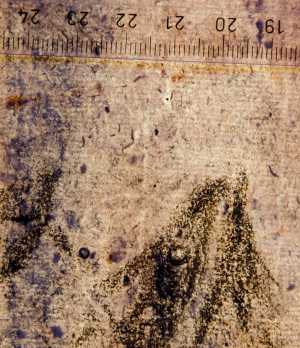Specifications
| Title | Study of two Pages |
|---|---|
| Material and technique | Black chalk and oiled black chalk on buff paper |
| Object type |
Drawing
> Two-dimensional object
> Art object
|
| Location | This object is in storage |
| Dimensions |
Height 296 mm Width 166 mm |
|---|---|
| Artists |
Draughtsman:
Leandro Bassano (Leandro da Ponte)
|
| Accession number | I 60 recto (PK) |
| Credits | Loan Stichting Museum Boijmans Van Beuningen (former Koenigs collection), 1940 |
| Department | Drawings & Prints |
| Acquisition date | 1940 |
| Creation date | in circa 1592 |
| Watermark | Circle, horizontally sectioned, with flower or cross on it (51 x 26 mm, upside down, on P2 of 6P, right of center, vH), somewhat similar to Briquet 3039 (Tyrol 1560). [see image] |
| Collector | Collector / Franz Koenigs |
| Mark | F.W. Koenigs (L.1023a) |
| Provenance | Franz W. Koenigs (1881-1941, L.1023a), Haarlem, acquired in 1927; D.G. van Beuningen (1877-1955), Rotterdam, acquired with the Koenigs Collection in 1940 and donated to Stichting Museum Boijmans Van Beuningen |
| Exhibitions | Amsterdam 1953, no. T 4; Venice/Florence 1985, no. 34; Rotterdam 2009 (coll 2 kw 2) |
| Internal exhibitions |
De Collectie Twee - wissel II, Prenten & Tekeningen (2009) |
| Research |
Show research Italian Drawings 1400-1600 |
| Literature | Von Hadeln 1926a, pl. 88; Tietze/Tietze-Conrat 1944, under no. 94; Amsterdam 1953, no. T 4; Arslan 1960, vol. 1, p. 268; Ballarin 1969, pp. 87, 88, 110, fig. 100; London 1979, p. 37 under note 41; Rearick 1980, p. 50; Aikema/Meijer 1985, no. 34, ill.; Rearick 2001, pp. 177-78 |
| Material | |
| Object | |
| Geographical origin | Italy > Southern Europe > Europe |
| Place of manufacture | Venice > Veneto region > Italy > Southern Europe > Europe |
Do you have corrections or additional information about this work? Please, send us a message

























